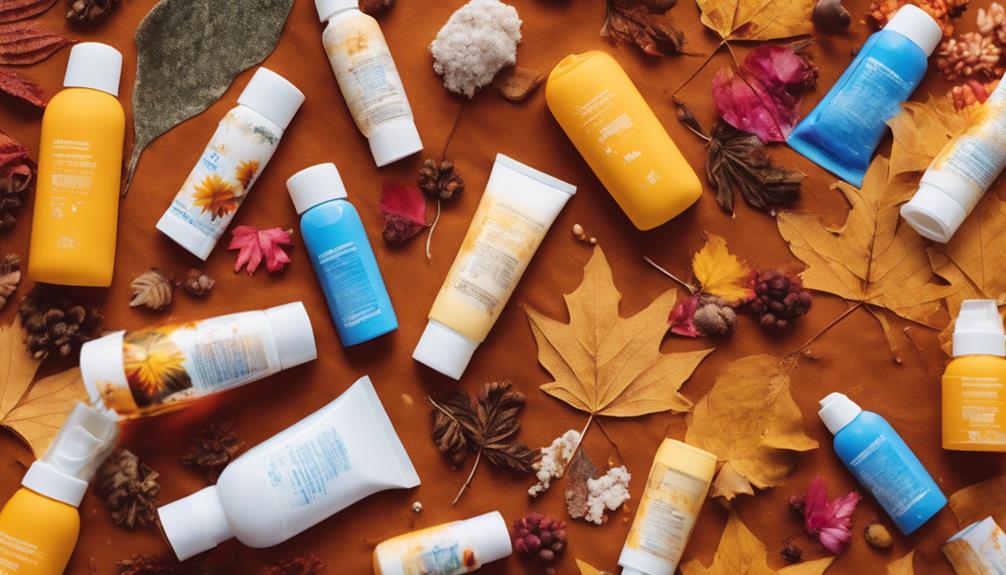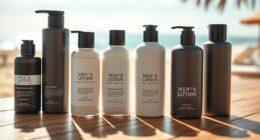Choosing the best sunscreen for every season is key to protecting your skin year-round. For summer, grab Banana Boat Ultra Sport SPF 50 for water resistance or Neutrogena Ultra Sheer Dry-Touch SPF 70 for a lightweight option. In fall, hydrate with EltaMD UV Clear SPF 46 while still blocking harmful rays. Winter calls for Neutrogena Hydro Boost Water Gel Lotion SPF 30, which helps prevent dryness. In spring, opt for Supergoop Unseen Sunscreen SPF 40 for a non-greasy feel. Each season has its top picks, and there's much more to explore on what works best for your skin.
Key Takeaways
- Spring: Choose lightweight and water-resistant options like Supergoop Unseen Sunscreen SPF 40 and Banana Boat Ultra Sport SPF 50 for outdoor activities.
- Summer: Opt for water-resistant sunscreens such as Banana Boat Ultra Sport SPF 50 and lightweight Neutrogena Ultra Sheer Dry-Touch SPF 70 for effective protection.
- Fall: Use moisturizing sunscreens like EltaMD UV Clear SPF 46 that hydrates while providing broad-spectrum protection against UV rays.
- Winter: Select thicker formulas like Neutrogena Hydro Boost Water Gel Lotion SPF 30 to combat dryness and reflect UV rays off snow.
Types of Sunscreens
When choosing a sunscreen, you'll encounter various types, each designed to cater to different skin needs and preferences.
Mineral sunscreens, which use active ingredients like zinc oxide and titanium dioxide, reflect UVA and UVB rays. They're often recommended for sensitive skin due to their gentle formulation.
On the other hand, chemical sunscreens absorb these rays using organic compounds such as avobenzone and octinoxate. They typically offer a lighter texture, making them easier to apply and less visible on your skin.
If you're looking for options that protect the environment, consider reef-safe sunscreens. These avoid harmful ingredients like oxybenzone and octinoxate, ensuring that marine life stays safe while you enjoy effective sun protection.
For those who lead active lifestyles, water-resistant formulas are a must. They maintain their SPF protection for up to 80 minutes while swimming or sweating.
Seasonal Recommendations

As the seasons change, so should your sunscreen choices to guarantee ideal protection and skin health.
In spring, go for lightweight formulas like Supergoop Unseen Sunscreen SPF 40. This mineral sunscreen offers high sun protection without a greasy feel, perfect for outdoor activities as temperatures rise.
When summer hits, you'll need water-resistant options like Banana Boat Ultra Sport SPF 50. This sunscreen provides up to 80 minutes of protection while you swim or sweat, ensuring you stay protected on those beach days.
In the fall, consider moisturizing sunscreens such as EltaMD UV Clear SPF 46. Not only does it shield against harmful UV rays, but it also hydrates your skin as the weather cools.
Finally, for winter, opt for thicker formulas like Neutrogena Hydro Boost Water Gel Lotion SPF 30. This hydrating sunscreen protects you from the sun's rays and reflects off snow, which can intensify UV exposure.
Year-round, always choose broad-spectrum sunscreens with SPF 30 or higher to block both UVA and UVB rays, ensuring your skin stays healthy and protected no matter the season.
Top Picks for Summer

Looking for the best summer sunscreens to keep your skin protected and feeling great? You've got plenty of options that meet your needs.
For those hot days spent by the pool or at the beach, consider water-resistant formulas like Banana Boat Ultra Sport SPF 50. This sunscreen offers protection for up to 80 minutes, ensuring you stay covered while swimming or sweating.
If you prefer a lightweight option, Neutrogena Ultra Sheer Dry-Touch SPF 70 is a fantastic choice. Its non-greasy formulation absorbs quickly and provides broad-spectrum protection without leaving a heavy residue on your skin.
For those with sensitive skin, mineral sunscreens like EltaMD UV Sport SPF 30 are ideal. They create a physical barrier against harmful UV rays, reducing the risk of irritation. Remember, SPF 50 blocks about 98% of UVB rays, making it perfect for all-day sun exposure.
To maximize your protection against UV damage, don't forget to reapply sunscreen every two hours, especially after swimming or sweating.
With these top picks, you'll enjoy a fun and safe summer under the sun!
Best Options for Winter

Even in winter, protecting your skin from UV rays is vital, so choosing a broad-spectrum sunscreen with SPF 30 or higher is a smart move. Even on cloudy days, UV rays can still damage your skin, making consistent protection essential.
Look for moisturizers or sunscreens that feature hydrating ingredients like hyaluronic acid and glycerin to help combat the dryness that cold weather brings.
Mineral sunscreens with zinc oxide or titanium dioxide are fantastic options during winter. They offer skin-soothing properties and are less likely to irritate sensitive skin. If you enjoy winter sports, opt for water-resistant formulations to guarantee your sunscreen lasts longer against sweat and moisture from snow.
Don't forget the importance of reapplication every two hours, especially after sweating or towel drying. This keeps your skin protected and helps maintain its moisture levels.
Effective Choices for Spring

Choosing the right sunscreen for spring is essential as UV exposure increases and outdoor activities become more frequent.
Dermatologists recommend using a broad-spectrum sunscreen with an SPF of 30 or higher to guarantee effective protection against harmful rays. Lightweight, non-greasy formulas like Supergoop Unseen Sunscreen SPF 40 are perfect for daily wear, as they won't clog your pores.
As you shift to outdoor activities, opt for water-resistant options such as Banana Boat Ultra Sport SPF 50, which can withstand sweat and light rain for up to 80 minutes. This is vital for those active spring days.
If you have sensitive skin, consider fragrance-free products like Blue Lizard Sensitive Mineral Sunscreen SPF 50 to minimize irritation and allergies.
For an added bonus, tinted sunscreens like CeraVe Tinted Sunscreen SPF 30 not only provide sun protection but also offer light coverage to even out your skin tone during sunnier days.
With these effective choices, you can enjoy the beauty of spring while keeping your skin protected. Remember, applying sunscreen regularly is key to maintaining healthy skin throughout the season!
Ideal Sunscreens for Fall

As fall rolls in, it's essential to keep up your daily sunscreen routine, since UV rays can still be strong.
You'll want lightweight formulations that won't weigh your skin down but still provide the protection you need.
Importance of Daily Protection
Daily sunscreen application is essential in fall, as harmful UV rays can still reach your skin, even on cloudy days. The American Academy of Dermatology recommends using a broad-spectrum sunscreen with at least SPF 30 to guard against both UVA and UVB rays.
As the weather cools, you might notice your skin becoming drier. That's why moisturizers with added SPF, like CeraVe Hydrating Mineral SPF 30, are perfect for keeping your skin hydrated while offering vital sun protection.
Don't underestimate sun exposure during your fall activities, whether you're hiking or playing sports. Opt for water-resistant formulas to guarantee your skin remains protected, even if you work up a sweat.
Additionally, consider sunscreens with antioxidant ingredients, such as Coola Classic Face Organic Sunscreen Lotion. These ingredients help combat oxidative stress from environmental factors typical of fall.
Lightweight Formulations for Fall
Shifting to lightweight formulations in fall not only hydrates your skin but also guarantees you stay protected without feeling weighed down. As the air gets drier, mineral sunscreens like EltaMD UV Clear SPF 46 are perfect for sensitive skin, offering the hydration you need.
Look for options packed with antioxidants, such as Coola Classic Face Organic Sunscreen Lotion SPF 50, which helps combat environmental stressors common in the fall. Non-greasy and lightweight, Supergoop! Unseen Sunscreen SPF 40 absorbs quickly, making it ideal for layering under makeup without leaving a white cast.
If you're worried about unexpected rain, consider water-resistant formulas like Neutrogena Ultra Sheer Dry-Touch SPF 70, ensuring your protection holds up against the elements.
Key Features to Consider

When choosing a sunscreen, focus on key features like SPF rating, broad spectrum protection, and compatibility with your skin type to secure ideal protection year-round. These elements are essential for preventing skin damage and reducing the risk of skin cancer.
| Feature | What to Look For | Why It Matters |
|---|---|---|
| SPF Rating | SPF 30 or higher | Filters about 97% of UVB rays |
| Broad Spectrum | Labels stating 'broad spectrum' | Protects against both UVA and UVB rays |
| Water Resistance | Formulas effective for up to 80 minutes | Ideal for swimming or sweating |
| Skin Type Compatibility | Mineral sunscreens for sensitive skin | Reduces irritation and breakouts |
| Active Ingredients | Zinc oxide or titanium dioxide (mineral); avobenzone (chemical) | Guarantees effective protection for all skin types |
Frequently Asked Questions
What Is the #1 Best Sunscreen?
When you're searching for the best sunscreen, consider Murad Multivitamin Clear Coat SPF 50. It's lightweight, absorbs quickly, and offers excellent protection while nourishing your skin, making it perfect for daily use and makeup.
What Is the Best Dermatologist Recommended Sunscreen?
Choosing the right sunscreen is like finding a trusted shield for your skin's armor. Dermatologists suggest broad-spectrum options like EltaMD UV Clear or Neutrogena Ultra Sheer, ensuring you're well-protected against the sun's relentless rays.
Which Brand Is Best for Sunscreen?
When choosing the best sunscreen brand, consider Neutrogena for lightweight formulas, Supergoop! for innovative textures, or CeraVe for skin benefits. Each brand offers unique features, so pick one that fits your needs perfectly.
What Kind of Sunscreen Is Good for Everyday Use?
For everyday use, choose a broad-spectrum sunscreen with SPF 30 or higher. Opt for lightweight, non-greasy formulas that absorb quickly. Don't forget to reapply every two hours for ideal protection!
What are the Best Sunscreens for Summer?
Looking for simple summer skin change? Choose the best sunscreens for summer. Look for a broad-spectrum SPF of 30 or higher to protect against UVA and UVB rays. Consider a water-resistant formula for outdoor activities. Opt for non-comedogenic and fragrance-free options for sensitive skin.
Conclusion
Choosing the right sunscreen for each season is essential for protecting your skin year-round.
With so many options available, how do you guarantee you're getting the best protection tailored to your needs?
Remember to take into account factors like SPF, water resistance, and skin type when making your selection.
By using our top picks, you can enjoy the sun safely, no matter the season.
So, are you ready to find your perfect sunscreen match?









